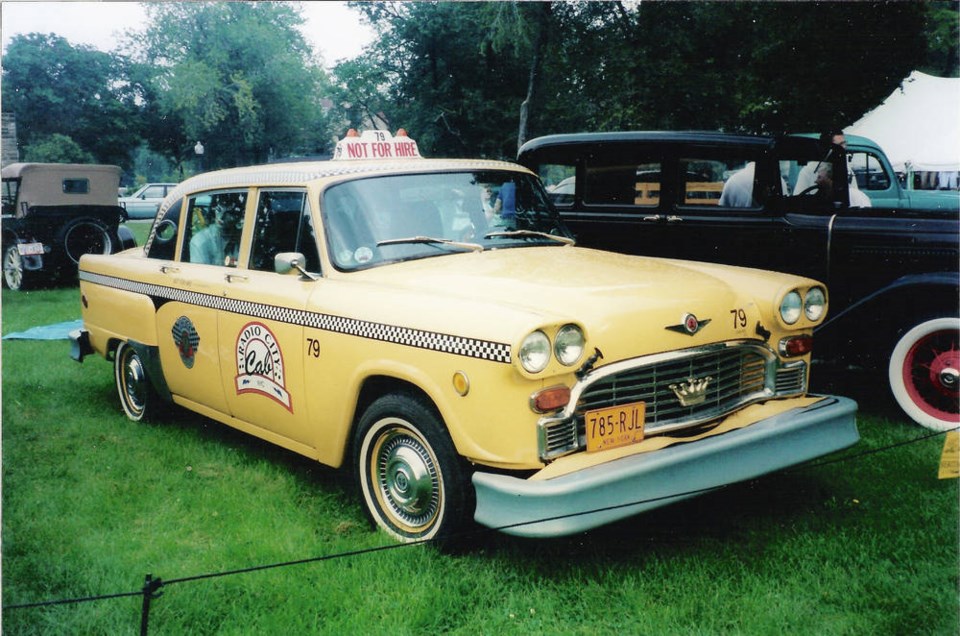If one were describing the ideal taxicab it would likely be a tall, roomy, durable vehicle with big doors, lots of space inside, an ample trunk and maybe a couple of extra seats. One could be describing the Checker, the most famous North American cab, and one that no doubt appeared in more movies than the most famous screen star.
The Checker had a convoluted history that traced back to a high wheeled car whimsically named the Seven Little Buffaloes. It was manufactured in Buffalo, N.Y., in 1909 by the De Schaum Motor Syndicate and few were built before De Schaum failed.
William De Schaum relocated to the Midwest and established De Schaum Motor Car Co. in Ecorse, Michigan to build a car called the Suburban. It was also not very successful, and Mr. De Schaum departed under a cloud.
Suburban was taken over by ex-Cartercar executive Randall Palmer and reorganized as Palmer Motor Car Co. It soon joined with the Partin automobile sales agency in Chicago to become Partin-Palmer making cars of that name.
Partin-Palmer reorganized into Commonwealth Motors Co. of Joliet, Ill, in 1915 and Partin-Palmers became Commonwealths in 1917. The Checker cab began to evolve when Commonwealth ventured into the taxi business with sturdy vehicles in four, and later six-cylinder engines.
By the early 1920s the company sensed a growing taxicab market and began building cabs fitted with bodies supplied by Markin’s Markin Auto Body Corp., also of Joliet. The Checker name came about when a fleet order came from Checker Taxi Co. of Chicago.
In spite of Checker’s business, Commonwealth was failing so Morris Markin merged it with his auto body company in 1921, changing the name to the Checker, Cab Manufacturing Co. He also entered the taxi business, gaining control of the Checker Taxi Co. by the late 1930s.
Production of Checkers began in mid-1922, and the following year Markin relocated the operation to its ultimate home, Kalamazoo, Mich., apparently to escape Chicago’s vicious gang warfare which included taxi-cab operations.
By luring some of the best staff, notably chief engineer Leland Goodspeed, from Barley Motor Car Co. of Kalamazoo, producer of the Pennant taxi, Checker produced sound cabs that sold well through the 1920s. By 1925 production reached 75 a week.
Checker survived the Depression and for a short time even became part of E.L. Cord’s empire. It developed several models, including six-and eight-door stretched versions for hotels and airports. It also tried selling cars to the public during the early thirties with little success.
During the Second World War, Checker contributed to the war effort by producing such items as trailers and tank recovery units. When peace came it returned to its pre-war designs, and enticed by the post-war pent-up demand for cars again tried the civilian market in the late ’40s. They soon abandoned it.
Checker became Checker Motors Corp. in 1958, and with the introduction of its all-new A8 model, decided to once more try the regular passenger car market with the 1960 Superba in both sedan and wagon versions. The Superba was joined by the virtually identical Marathon which soon replaced the Superba name.
It was powered by the same 3.7 litre Continental side-valve, six-cylinder engine used by Kaiser-Frazer until they stopped making cars in North America in 1955. Of the almost 7,000 1960 Checkers produced approximately 1,000 went to private owners.
This response encouraged Checker to continue public sales but the Continental engine was getting a little underpowered despite an optional overhead-valve version. Checker started using Chevrolet sixes and eights in 1965, plus a few Perkins diesels.
Checker continued producing 5,000 to 7,000 cars a year, mostly taxis, through the 1960s, peaking at 8,173 in 1962. Founder Markin remained in control until his death in 1970 when his son David Markin over.
The Checker Co. went into decline in the early 1970s. Its cars were now out of date, being basically the same model that had come out in the ’50s. Another factor was that the big Detroit automakers had started discounting models for fleet buyers, and with its relatively high overhead costs Checker could not remain competitive.
Edward Cole, an engineer who had retired as president of General Motors in 1974, joined Checker as chairman and chief executive officer. His dynamic presence was expected to result in a new model, but unfortunately Cole was killed in 1977 in a plane crash flying to a meeting in Kalamazoo.
Although several new model ideas were considered, including a stretched Volkswagen Rabbit and a version based on GM X-body (Chevrolet Citation, et al.) components, none came to fruition.
With production down to the 500-a-year range and the prices it had to charge making it uncompetitive, Checker went out of business in 1982, its 60th anniversary.



